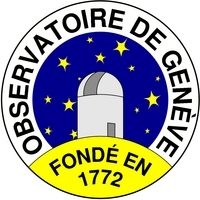
| INTEGRALPlanckGaiaPOLARCHEOPSEuclidATHENA |
| HEAVENSFACTCTALOFTSPICAJEM-EUSOXIPEeXTPTheseus |
| XRISMMAGBOUNDSMARTNet |
| ISDCCDCI |
| Data Centre for Astrophysics Astronomy Department of the University of Geneva |
| ISDC Seminar |
Paula Texeira
ESO, Garching, Germany
Spitzer's view of NGC 2264's circumstellar disk population
Abstract. Circumstellar disks are a natural by-product of star-formation and they are the birthing sites of planetary systems. The characterization of these disks and their evolution is therefore crucial to understand and identify the initial conditions for planet formation. I will present our results on the characterization of the disk population in the young cluster NGC 2264. The disked sources were identified by their excess emission at wavelengths between 3.6 and 24 microns, and classified according to their spectral energy distribution shapes. Our results have led us to hypothesize that there may be two distinct evolutionary paths for disks: a homologous one where the disk emission decreases uniformly in near- and mid-infrared wavelengths and throughout which most sources pass, and a radially differential one where the emission from the inner region of the disk decreases more rapidly than from the outer region. Whether a disk evolves in a homologously or radially depleted fashion may be indicative of the nature of planet formation in the disk.
>> Notice
>> List of ISDC seminars







